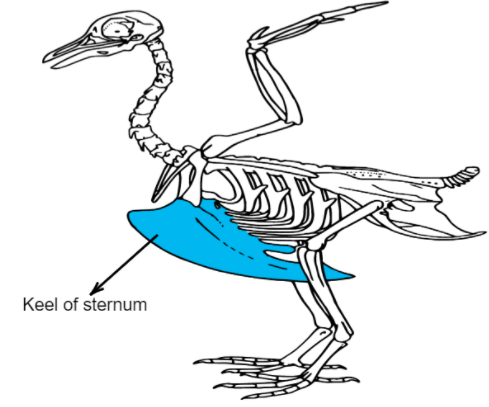
The mallard duck possesses a keeled sternum. What is the function of this specialized bone structure?
A) To provide stability in water
B) To provide a site of attachment for the large flight muscles
C) To increase the body’s surface area for heat exchange
D) It is a weapon used in sexual competition between males
Answer
555k+ views
Hint:Bone structure of birds seems like a light, yet still strong bone structure is a requirement for flight. Bird bones are laced with air cavities. Their hollow bone structure to minimize weight. Sternum is the breastbone. Keel cedes an anchor to which a bird’s wing muscles attach, so providing adequate leverage for flight.
Complete answer:
Birds are archosaurs, and have ancestors with diapsid skulls. Birds skulls are highly specialized- mostly fused into one piece. A keel in bird anatomy is an augmentation of the sternum, which runs axially along the midline of the sternum and stretched outwards, perpendicular to the plane of ribs. The sternum has a keel- like projection to which the pectoral muscles attached. These muscles provide the all-important down stroke in powered flight. In contrast, flightless sternum.

So, keel sternum provides area for the large flight muscles to attach.
Thus, the correct answer is option (B).
Note:Birds have three types of flight muscles, they are pectoral muscles, accessory muscles, tensor muscles. Large flight muscles help in flying. Perching muscle helps with perching. Carina is another name of keel (plural: carinae), ratite is the group of flightless and mostly large and long-legged birds.
Complete answer:
Birds are archosaurs, and have ancestors with diapsid skulls. Birds skulls are highly specialized- mostly fused into one piece. A keel in bird anatomy is an augmentation of the sternum, which runs axially along the midline of the sternum and stretched outwards, perpendicular to the plane of ribs. The sternum has a keel- like projection to which the pectoral muscles attached. These muscles provide the all-important down stroke in powered flight. In contrast, flightless sternum.

So, keel sternum provides area for the large flight muscles to attach.
Thus, the correct answer is option (B).
Note:Birds have three types of flight muscles, they are pectoral muscles, accessory muscles, tensor muscles. Large flight muscles help in flying. Perching muscle helps with perching. Carina is another name of keel (plural: carinae), ratite is the group of flightless and mostly large and long-legged birds.
Recently Updated Pages
Master Class 11 Social Science: Engaging Questions & Answers for Success

Master Class 11 Physics: Engaging Questions & Answers for Success

Master Class 11 Maths: Engaging Questions & Answers for Success

Master Class 11 Economics: Engaging Questions & Answers for Success

Master Class 11 Computer Science: Engaging Questions & Answers for Success

Master Class 11 Chemistry: Engaging Questions & Answers for Success

Trending doubts
What is meant by exothermic and endothermic reactions class 11 chemistry CBSE

10 examples of friction in our daily life

One Metric ton is equal to kg A 10000 B 1000 C 100 class 11 physics CBSE

Difference Between Prokaryotic Cells and Eukaryotic Cells

1 Quintal is equal to a 110 kg b 10 kg c 100kg d 1000 class 11 physics CBSE

Draw a diagram of nephron and explain its structur class 11 biology CBSE




